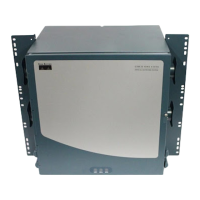6-60
Cisco ONS 15454 Procedure Guide, R5.0
August 2005
Chapter 6 Create Circuits and VT Tunnels
NTP-A192 Create a Circuit for an E-Series Card in Port-Mapped Mode
Step 7 Click Next.
Step 8 Define the circuit attributes:
• Name—Assign a name to the circuit. The name can be alphanumeric and up to 48 characters
(including spaces). Circuit names should be 44 characters or less if you want the ability to create
monitor circuits. If you leave the field blank, CTC assigns a default name to the circuit.
• Size—Choose the circuit size. Valid circuit sizes for an E-Series circuit are STS-1, STS-3c, STS6c,
and STS-12c.
• Bidirectional—Leave the default unchanged (checked).
• Create cross-connects only (TL1-like)—Uncheck this box.
• State—Choose the administrative state to apply to all of the cross-connects in a circuit:
–
IS—Puts the circuit cross-connects in the IS-NR service state.
–
OOS,DSBLD—Puts the circuit cross-connects in the OOS-MA,DSBLD service state. Traffic is
not passed on the circuit.
–
IS,AINS—Puts the circuit cross-connects in the OOS-AU,AINS service state and suppresses
alarms and conditions. When the connections receive a valid signal, the service state
automatically changes to IS-NR.
–
OOS,MT—Puts the circuit cross-connects in the OOS-MA,MT service state. The maintenance
state does not interrupt traffic flow; it suppresses alarms and conditions and allows loopbacks
to be performed on the circuit. Use OOS,MT for circuit testing or to suppress circuit alarms
temporarily. Change the administrative state to IS; IS,AINS; or OOS,DSBLD when testing is
complete. See the “DLP-A230 Change a Circuit Service State” task on page 19-19.
For additional information about circuit service states, refer to the “Circuits and Tunnels” chapter
in the Cisco ONS 15454 Reference Manual.
• Apply to drop ports—Check this check box if you want to apply the state chosen in the State field
(IS or OOS-MT only) to the Ethernet circuit source and destination ports. You cannot apply
OOS-AINS to E-Series Ethernet card ports. CTC applies the circuit state to the ports only if the
circuit bandwidth is the same as the port bandwidth or, if the port bandwidth is larger than the
circuit, the circuit must be the first circuit to use the drop port. If not, a Warning dialog box shows
the ports where the circuit state could not be applied. If the box is unchecked, CTC does not change
the state of the source and destination ports. For the requirements necessary to apply a service state
to drop ports, refer to the Cisco ONS 15454 Reference Manual.
Note Loss of signal alarms are generated if ports in the IS-NR service state are not receiving
signals.
• Auto-ranged—Unavailable.
• Protected Drops—Leave the default unchanged (unchecked).
Step 9 If the circuit will be routed on a path protection, complete the “DLP-A218 Provision Path Protection
Selectors” task on page 19-12.
Step 10 Click Next.
Step 11 Provision the circuit source:
a. From the Node drop-down list, choose the circuit source node. Either end node can be the
point-to-point circuit source.

